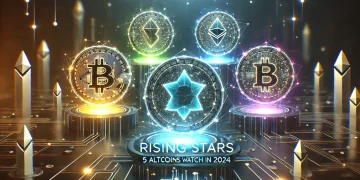The world of cryptocurrency has evolved rapidly since Bitcoin’s inception in 2009, creating a thriving ecosystem of alternative cryptocurrencies, or “altcoins.” While Bitcoin remains the most well-known digital currency, the altcoin market has exploded with a variety of innovative projects aimed at solving various issues in finance, technology, and beyond. As we move into 2024, several altcoins show immense potential, offering investors and enthusiasts exciting opportunities.
In this article, we’ll explore the top 10 altcoins to watch in 2024, each with promising technology, strong development teams, and unique use cases. Whether you’re a seasoned crypto investor or new to the space, these projects are worth paying attention to.
1. Ethereum (ETH): The Backbone of DeFi and Smart Contracts
Market Cap: Over $500 billion
Use Case: Decentralized applications (DApps) and smart contracts
Ethereum remains the king of altcoins and continues to be a cornerstone of the cryptocurrency ecosystem. Known for its smart contract functionality, Ethereum has been the foundation for numerous decentralized applications (DApps) and the vast majority of decentralized finance (DeFi) projects. With the successful transition to Ethereum 2.0, which introduced proof-of-stake (PoS) consensus, the network now boasts significantly higher energy efficiency and scalability.
2024 is expected to bring further advancements to the Ethereum ecosystem, such as Layer 2 scaling solutions (e.g., Optimism and Arbitrum) that will continue to reduce transaction fees and enhance network speed. Ethereum’s dominance in DeFi, non-fungible tokens (NFTs), and Web3 development makes it a must-watch altcoin.
2. Solana (SOL): High-Speed Blockchain for DApps and DeFi
Market Cap: Over $10 billion
Use Case: High-performance blockchain for decentralized applications
Solana has emerged as one of the fastest and most efficient blockchains in the crypto space. Known for its ultra-fast transaction speeds and low costs, Solana aims to solve the scalability issues that have plagued Ethereum and other blockchains. With its proof-of-history (PoH) consensus mechanism, Solana can handle thousands of transactions per second, making it ideal for DeFi, NFTs, and other blockchain applications.
In 2024, Solana’s ecosystem is expected to expand further as developers continue to build on the network, attracted by its performance and low fees. Despite facing network outages in 2022 and 2023, the Solana team has implemented significant upgrades, improving network stability and reliability.
3. Polygon (MATIC): Ethereum’s Internet of Blockchains
Market Cap: Over $7 billion
Use Case: Scaling solution for Ethereum
Polygon, previously known as Matic Network, has gained significant traction as a Layer 2 scaling solution for Ethereum. By offering fast and low-cost transactions, Polygon addresses Ethereum’s scalability issues, allowing decentralized applications to run more efficiently. The platform’s interoperability with Ethereum makes it an attractive choice for developers looking to scale their projects without sacrificing Ethereum’s security.
2024 promises to be a pivotal year for Polygon, with continued adoption of its zk-rollups and sidechains that could further enhance transaction throughput and lower fees. As Ethereum continues to scale, Polygon will likely play a critical role in supporting the growth of DApps and DeFi protocols.
4. Cardano (ADA): A Scientific Approach to Blockchain
Market Cap: Over $12 billion
Use Case: Smart contracts and decentralized finance
Cardano is one of the most academically researched and peer-reviewed blockchains in the crypto space. Known for its scientific approach to development, Cardano’s unique proof-of-stake consensus mechanism, Ouroboros, offers energy-efficient and secure blockchain solutions. The release of smart contract functionality through the Alonzo upgrade in 2021 opened the doors for DeFi and NFT projects on the platform.
As we move into 2024, Cardano’s development roadmap, which includes features like Hydra (a Layer 2 scaling solution) and continued improvements to smart contract functionality, positions it as a strong contender in the DeFi space. The focus on sustainability and peer-reviewed research makes Cardano a reliable choice for long-term investors.
5. Avalanche (AVAX): The Internet of Finance
Market Cap: Over $5 billion
Use Case: DeFi, DApps, and enterprise blockchain solutions
Avalanche is a highly scalable blockchain platform designed to support a wide range of decentralized applications and enterprise solutions. Its consensus mechanism, Avalanche Consensus, enables near-instant transaction finality, making it one of the fastest blockchains in the space. Avalanche is also known for its robust interoperability features, allowing different blockchains to communicate and interact seamlessly.
2024 could see Avalanche solidifying its place in the DeFi and enterprise blockchain sectors. With several major DeFi platforms already operating on Avalanche, such as Aave and Curve, the network is set to expand further as new projects flock to its high-performance, low-cost infrastructure.
6. Polkadot (DOT): A Multi-Chain Network for Web3
Market Cap: Over $7 billion
Use Case: Interoperability between blockchains
Polkadot is designed to enable multiple blockchains to operate together in a unified network. Its unique parachain architecture allows individual blockchains to have their own governance while benefiting from shared security. This makes Polkadot a key player in the future of Web3, where seamless interoperability between different blockchains is essential.
The rollout of Polkadot’s parachains has been one of the most anticipated developments, and 2024 could mark the year that Polkadot’s vision of a fully interconnected blockchain ecosystem becomes a reality. With more parachains launching, Polkadot is poised to host a wide variety of applications across DeFi, NFTs, and decentralized identity solutions.
7. Chainlink (LINK): Connecting Smart Contracts with Real-World Data
Market Cap: Over $6 billion
Use Case: Decentralized oracles
Chainlink is a decentralized oracle network that enables smart contracts to securely interact with real-world data, APIs, and off-chain payment systems. Oracles are a critical component of many DeFi applications, providing the data necessary for smart contracts to function autonomously. Chainlink has become the go-to solution for oracles, powering countless DeFi platforms and protocols.
As DeFi and other blockchain applications continue to grow in 2024, Chainlink’s role in providing reliable, decentralized data feeds will become even more important. New partnerships and integrations are expected to expand Chainlink’s presence across different blockchain networks, making it a cornerstone of the Web3 ecosystem.
8. Arbitrum (ARB): A Leading Layer 2 Solution for Ethereum
Market Cap: Over $2 billion
Use Case: Scaling Ethereum with Layer 2 solutions
Arbitrum is one of the most promising Layer 2 scaling solutions for Ethereum, designed to reduce congestion on the Ethereum network by processing transactions off-chain while still benefiting from Ethereum’s security. Arbitrum’s rollup technology allows it to achieve much lower gas fees and faster transactions compared to the main Ethereum chain.
In 2024, Arbitrum is expected to continue gaining traction as more DeFi protocols and DApps migrate to Layer 2 solutions to escape high gas fees. Arbitrum’s growing ecosystem and the introduction of new features such as native tokens could further enhance its appeal to developers and users alike.
9. Cosmos (ATOM): Building the Internet of Blockchains
Market Cap: Over $3 billion
Use Case: Interoperability and blockchain communication
Cosmos aims to create an “Internet of Blockchains” by enabling multiple independent blockchains to communicate and exchange data through its Inter-Blockchain Communication (IBC) protocol. This allows different blockchain networks to interoperate while maintaining their own sovereignty, making Cosmos a key player in the future of blockchain interoperability.
As more blockchains seek to integrate with one another, Cosmos’ role in facilitating these connections will likely grow. In 2024, the adoption of IBC could skyrocket, with more projects utilizing Cosmos to bridge disparate blockchain networks, further enhancing its value proposition.
10. Aptos (APT): The Scalable Layer 1 Solution
Market Cap: Over $1.5 billion
Use Case: High-performance blockchain for decentralized applications
Aptos is a relatively new player in the Layer 1 blockchain space but has gained attention for its highly scalable and efficient design. Built by a team of former Facebook engineers, Aptos is designed to process tens of thousands of transactions per second, making it one of the fastest blockchains on the market.
With a focus on usability and developer experience, Aptos is positioning itself as a strong contender in the Layer 1 blockchain race. In 2024, as more DApps and DeFi projects seek out scalable alternatives to Ethereum, Aptos could see significant adoption and network growth.
Conclusion: The Altcoin Landscape in 2024
As we head into 2024, the altcoin landscape is more exciting than ever, with a diverse range of projects offering innovative solutions across various industries. From Ethereum’s continued dominance in DeFi to newer players like Aptos pushing the boundaries of scalability, the top 10 altcoins listed here represent the cutting edge of blockchain technology.
For investors and enthusiasts, keeping an eye on these projects could provide valuable insights into the future of cryptocurrency and blockchain development. While the market can be volatile, these altcoins stand out due to their strong fundamentals, active development communities, and potential for real-world adoption.
FAQs
- What are altcoins?
Altcoins are cryptocurrencies other than Bitcoin. They include a wide variety of projects with different use cases, such as smart contracts, decentralized finance, and cross-chain interoperability. - Why is Ethereum still considered a top altcoin?
Ethereum is the leading platform for decentralized applications and smart contracts, making it a cornerstone of the DeFi and NFT ecosystems. Its transition to proof-of-stake has improved scalability and energy efficiency. - What makes Solana different from Ethereum?
Solana offers faster transaction speeds and lower fees compared to Ethereum, thanks to its proof-of-history consensus mechanism. This makes it ideal for high-performance applications, though it has faced network stability issues in the past. - Is Cardano a good long-term investment?
Cardano’s focus on peer-reviewed research and sustainability makes it a solid choice for long-term investors. Its roadmap includes several updates aimed at enhancing scalability and functionality. - What are Layer 2 solutions like Polygon and Arbitrum?
Layer 2 solutions are built on top of existing blockchains (e.g., Ethereum) to improve scalability by processing transactions off-chain, reducing congestion, and lowering fees. - Which altcoin has the most potential for growth in 2024?
While all the projects listed have strong potential, Solana, Avalanche, and Arbitrum are particularly well-positioned for significant growth due to their focus on scalability and growing ecosystems.















































